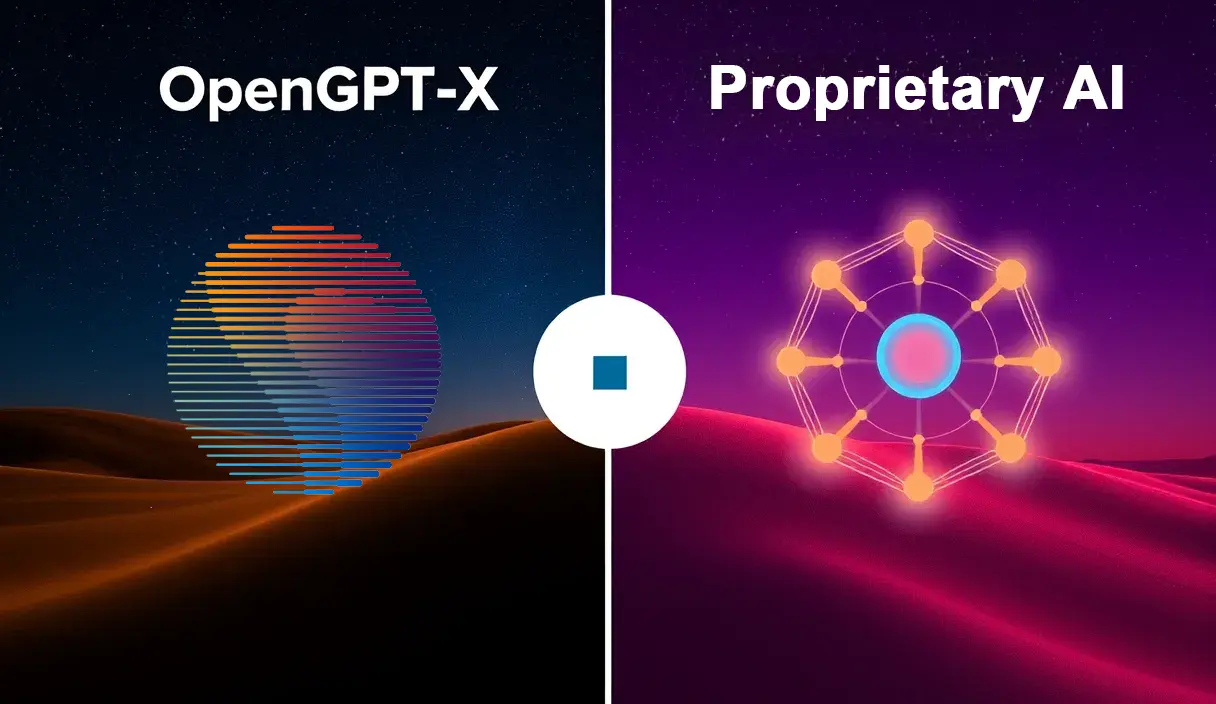
What Sets OpenGPT-X Apart from Proprietary Models?
OpenGPT-X is an open-access initiative that seeks to democratize AI technology. Unlike proprietary AI models like OpenAI’s GPT series or Google’s Bard, OpenGPT-X emphasizes transparency, collaboration, and customization.

Proprietary models often come with restrictions: usage fees, limited modification rights, and closely guarded algorithms. In contrast, open-access systems thrive on community contributions and adaptability. This makes OpenGPT-X a favorite for developers aiming to innovate without corporate roadblocks.
But with freedom comes responsibility. Open-access platforms lack centralized oversight, which can lead to inconsistent updates or ethical misuse. So, is the trade-off worth it?
Performance and Innovation: Who’s Leading the Race?
Performance metrics often define an AI’s success. Proprietary models invest billions in data training and computational power, resulting in highly refined outputs. OpenGPT-X, though impressive, can lag behind in fine-tuned performance due to limited resources.
However, open-access models encourage grassroots innovation. Developers worldwide can tweak the core system, creating unique solutions. This diversity can sometimes outperform the one-size-fits-all approach of proprietary models.
Take open-source AI plugins as an example. These are often developed faster and address niche needs more effectively than their proprietary counterparts.
Transparency and Ethical AI: Open vs. Closed Systems
Transparency is where OpenGPT-X truly shines. Its open-source nature allows researchers and developers to audit, modify, and improve the codebase. This fosters trust and collaboration, which are essential for ethical AI development.
Proprietary models, on the other hand, operate in black boxes. Users often have no insight into how decisions are made, leading to concerns about bias and accountability.
That said, transparency can be a double-edged sword. Open systems risk exposing vulnerabilities that malicious actors can exploit. Proprietary models’ secrecy may protect against such risks but can stifle trust.

Cost and Accessibility: Breaking Down the Barriers
One of OpenGPT-X’s biggest advantages is its affordability. By eliminating hefty licensing fees, it makes cutting-edge AI accessible to smaller businesses and individual developers.
Proprietary AI, while powerful, often comes with steep subscription models or pay-per-use pricing. This creates a divide, limiting AI’s benefits to those with deep pockets.
Yet, investing in proprietary solutions can save time and effort. Pre-trained proprietary models often include customer support, streamlined APIs, and seamless integrations, making them more appealing to enterprise-level users.
Security Concerns: Is Open Always Safe?
Open-access models like OpenGPT-X face unique security challenges. With open code, vulnerabilities can become public knowledge, increasing risks of hacking or misuse.
Proprietary AI often has dedicated security teams, ensuring better protection for users and their data. However, this security comes at the cost of user independence. Companies control updates, policies, and access, potentially prioritizing profit over user needs.
So, is greater freedom worth the added risk? It depends on the user’s expertise and their ability to manage security independently.
Customization and Flexibility: OpenGPT-X’s Biggest Strength
One of the standout features of OpenGPT-X is its flexibility. Being open-access, developers can tailor it to meet specific requirements, from niche business applications to experimental research. The ability to tweak the core architecture enables endless possibilities for personalization.
Proprietary models, while powerful, often come with rigid frameworks. Users must work within predefined limitations or pay extra for custom enterprise solutions. For smaller teams or niche projects, this lack of freedom can be a significant drawback.
That said, proprietary platforms often come preloaded with advanced features, making them ideal for users seeking plug-and-play solutions without heavy technical involvement.
Community Support vs. Centralized Expertise
OpenGPT-X benefits from a global community of developers and enthusiasts. Open forums, GitHub repositories, and collaborative projects drive its evolution, ensuring it stays relevant and adaptive. This collective intelligence can lead to breakthroughs in unexpected areas.
By contrast, proprietary AI solutions have centralized support teams with specialized expertise. Users gain access to professional troubleshooting, training resources, and personalized assistance, which can be critical for high-stakes applications.
For those comfortable navigating developer communities, OpenGPT-X offers a more organic form of support. For others, the structured reliability of proprietary platforms may be more appealing.
Scalability: Open vs. Closed
Scalability is a major consideration for users deciding between open and closed systems. Proprietary AI models are often backed by massive infrastructure, making them well-suited for large-scale deployments. Their ability to handle high-volume tasks without significant downtime is a key selling point for enterprises.
OpenGPT-X, while scalable, relies heavily on the resources of individual users or hosting providers. This can introduce variability in performance for larger operations. However, cloud-hosted open-access platforms like Hugging Face have begun bridging this gap, making OpenGPT-X increasingly competitive.

Future-Proofing: Open Access Leading the Way?
When it comes to staying relevant, open-access platforms may have the edge. OpenGPT-X’s community-driven evolution means updates and features are constantly being added. As AI continues to evolve, this adaptability ensures users can stay ahead of the curve.
Proprietary AI models, while innovative, are tied to the priorities of their parent companies. If a feature isn’t profitable or widely demanded, it may be discontinued. This lack of control can leave users scrambling for alternatives.
Choosing the Right Model for Your Needs
Ultimately, the choice between OpenGPT-X and proprietary AI depends on your goals. Are you seeking customization and control? Or do you need a robust, pre-packaged solution with guaranteed performance?
For innovators and smaller teams, OpenGPT-X’s open-access ethos may unlock creative potential. For enterprises with high-stakes needs, proprietary systems offer a polished, reliable experience.
Both models have their strengths and weaknesses, and the right choice hinges on balancing freedom with convenience.
FAQs
Can OpenGPT-X compete with proprietary models in terms of accuracy?
It depends on the context. Proprietary models often have access to vast resources for training on large datasets, leading to high levels of refinement and accuracy in general use cases.
However, OpenGPT-X’s open framework allows developers to fine-tune it for specific niches. For instance, academic researchers working on legal text analysis could fine-tune OpenGPT-X with legal documents, achieving results comparable—or superior—to proprietary models in that domain.
Is OpenGPT-X secure for enterprise use?
Security in open-access systems like OpenGPT-X can be a double-edged sword. While its transparency allows thorough vetting for vulnerabilities, it also exposes the code to potential misuse by bad actors.
Enterprises using OpenGPT-X can implement additional safeguards, like private hosting and strict access controls. For example, a cybersecurity firm might deploy OpenGPT-X in a secure, on-premises environment to protect sensitive data.
Proprietary models typically have dedicated teams managing security, which can be reassuring for companies without in-house expertise.
How does OpenGPT-X support collaboration in AI development?
OpenGPT-X thrives on its community-driven model. Developers worldwide contribute plugins, improvements, and patches, making it a hub of collaborative innovation.
For instance, a developer creating a medical diagnostic assistant could benefit from pre-existing medical language models shared by other OpenGPT-X users. This shared pool of resources significantly reduces development time.
Proprietary systems lack this open collaboration, as their algorithms and tools are typically locked behind paywalls.
What industries benefit most from using OpenGPT-X?
Industries requiring custom solutions or operating on tight budgets often benefit the most from OpenGPT-X. These include:
- Education: Universities can create AI tutors tailored to local curricula.
- Healthcare: Clinics can build multilingual patient support systems on OpenGPT-X without expensive licensing.
- Startups: Early-stage businesses can experiment with AI without committing to costly platforms.
For example, an NGO developing an AI for drought prediction in sub-Saharan Africa might leverage OpenGPT-X to integrate localized weather patterns and agricultural data—something a proprietary model may not be flexible enough to handle.
Does OpenGPT-X require technical expertise to use?
Yes, OpenGPT-X requires some level of technical proficiency. Users need to understand programming concepts to customize or deploy it effectively. It’s well-suited for developers, researchers, and organizations with dedicated technical teams.
However, tools and platforms like Hugging Face or pre-configured AI frameworks are making OpenGPT-X more user-friendly. For example, a small marketing agency without in-house developers could use a third-party GUI-based interface to leverage OpenGPT-X for generating campaign ideas.
Proprietary models often provide ready-made tools and APIs, making them more accessible for non-technical users.
How does OpenGPT-X handle updates and support?
Updates in OpenGPT-X are community-driven, meaning developers contribute improvements over time. While this ensures continuous innovation, it can lead to inconsistencies or delayed resolutions if the community support isn’t robust.
For example, if a critical bug arises, you may need to rely on forums or GitHub discussions for solutions. Contrast this with proprietary models, where issues are handled by dedicated support teams, often with guaranteed response times.
Despite this, active communities can provide tailored advice, which is particularly useful for niche applications.
Can proprietary and open-access models be used together?
Absolutely. Many businesses and researchers use a hybrid approach, leveraging the strengths of both systems. For example, a company could use OpenGPT-X for experimenting with custom models while relying on proprietary systems for core operations.
A fintech startup might train a fraud detection algorithm with OpenGPT-X, integrating it into a larger proprietary system for streamlined financial data analysis. This approach allows the flexibility of open models and the reliability of proprietary ones.
What are some examples of OpenGPT-X in real-world applications?
OpenGPT-X has been applied across various sectors:
- Agriculture: AI models have been fine-tuned to monitor crop health and predict yield based on localized data.
- Content Creation: Bloggers and small media outlets use OpenGPT-X for affordable and adaptable content generation tools.
- Education: Schools in underfunded regions deploy OpenGPT-X for personalized learning platforms tailored to local languages.
These use cases demonstrate how OpenGPT-X empowers innovation in areas where proprietary models might be too restrictive or costly.
What future developments can we expect from OpenGPT-X?
The open-source nature of OpenGPT-X ensures that it evolves continuously. Developers are exploring improvements in areas like multilingual capabilities, ethical AI frameworks, and low-resource deployment.
For instance, we could see OpenGPT-X being optimized for edge devices, enabling AI applications in remote areas without reliable internet access. Additionally, collaborations between academic institutions and OpenGPT-X contributors could lead to breakthroughs in AI fairness and transparency.
As the ecosystem grows, OpenGPT-X is poised to challenge proprietary models in even more significant ways.
Resources
OpenGPT-X and Open-Source AI
- OpenGPT-X Official Documentation: Comprehensive guides and tutorials on using and customizing OpenGPT-X for various applications.
- Hugging Face: A platform offering pre-trained AI models and tools for deploying OpenGPT-X with minimal setup.
- GitHub OpenAI Projects: Discover community-driven projects built using OpenGPT-X and other open-source AI frameworks.
Proprietary AI Platforms
- OpenAI: Home of GPT-4 and ChatGPT, offering robust documentation, APIs, and enterprise solutions.
- Google AI: Learn about proprietary tools like Bard and Vertex AI for machine learning and AI development.
- Microsoft Azure AI: Explore AI models and APIs designed for scalable enterprise use.





